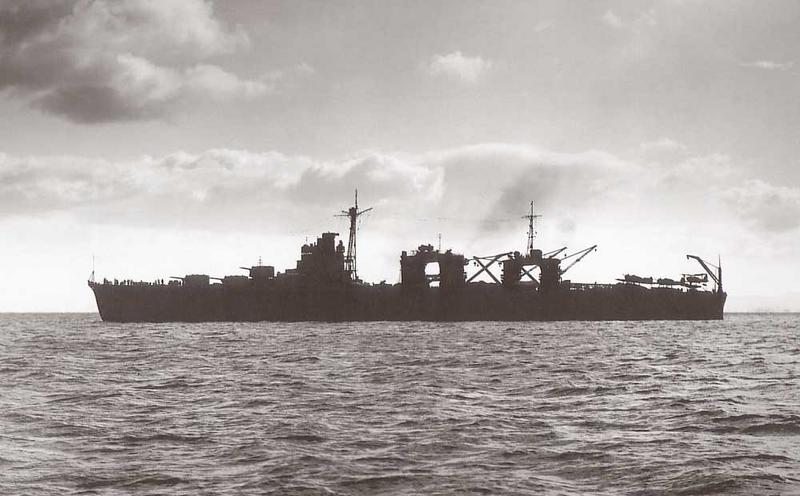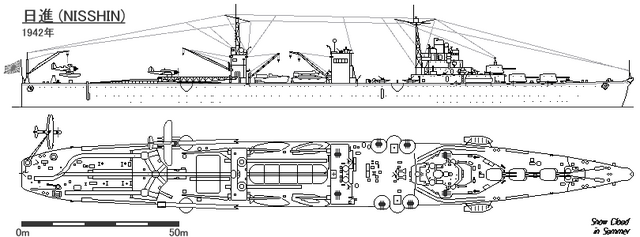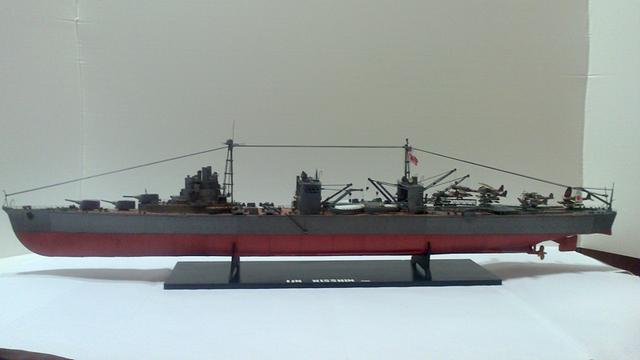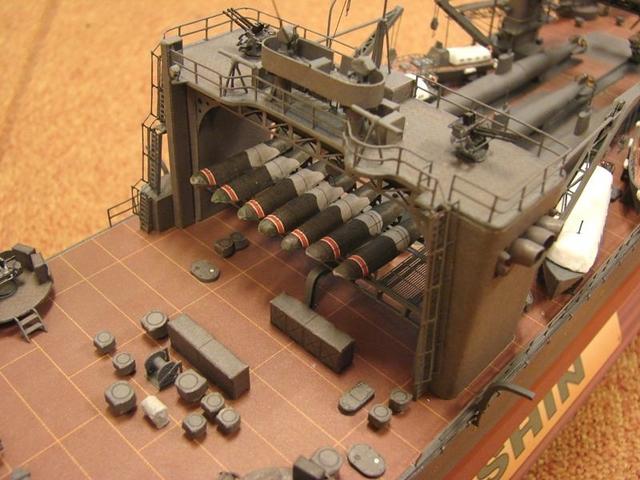
(
Nisshin at dawn/dusk, sometime in 1942)
From Wikipedia (consulted at 10:00 on 21/05/2018)
- During the 1930s, the Imperial Japanese Navy made increasing use of naval aviation as scouts for its cruiser and destroyer squadrons. Due to restrictions imposed by the Washington Naval Treaty and London Naval Treaty, the number of aircraft carriers was strictly regulated; however, there was no limitation as to seaplane tenders. Nisshin was a follow-on to the purpose-built seaplane tender design begun with the Chitose-class and was ordered by the Imperial Japanese Navy under the 3rd Naval Armaments Supplement Programme of 1937.
- Nisshin was laid down on 2 November 1938 and launched on 30 November 1939 at Kure Naval Arsenal. Her completion was delayed by design changes and the onset of the Pacific War and was not commissioned until 27 February 1942. Shortly after commissioning, on 20 March 1942 Nisshin was assigned to Vice Admiral Teruhisa Komatsuís IJN 6th Fleet together with the seaplane tender Chiyoda and the auxiliary cruiser Aikoku Maru, and participated in training exercises in the Inland Sea, during which time she recovered a miniature submarine which had been lost by Chiyoda.[5]
- During the Battle of Midway, Nisshin was part of Main Body of the Japanese fleet. For this operation, she carried twelve Type A Kō-hyōteki-class submarines, which were intended to be stationed at Kure Atoll, which was to be seized as a seaplane base for operations against Midway Atoll. The operation was cancelled on the loss of the Japanese aircraft carriers during the Battle of Midway, and Nisshin returned to Hashirajima with her submarines on 14 June without having seen combat.[5]
- From September 1942, Nisshin was at Kavieng in the Solomon Islands, where she was assigned to a number of Tokyo Express high speed transport runs to Guadalcanal through the end of November. These missions included the transport of artillery used during the Battle of Cape Esperance. On 28 September, she narrowly missed an attack by USS Sculpin (SS-191) east of the island of Kokoda. In October, she was damaged during an attack by an American dive bomber north of Tassafaronga. She was unloading at Tassafaronga during a subsequent run on 12 October when the Battle of Cape Esperance began, but was able with withdraw without engaging in combat. and in November she was withdrawn to Truk.[5]
- During the first half of 1943, Nisshin continued to be used primarily as a fast transport between the Japanese home islands and Truk and Rabaul. During a refit at Kure in February 1943, an additional 18 Type 97 25 mm AA guns were installed.[5]
- With the start of the large-scale Allied offensive in June 1943 against Japanese-occupied New Guinea and the Solomon Islands, Nisshin rushed troop reinforcements from Yokosuka to Bougainville Island. Loaded with 630 soldiers, 22 light tanks, ammunition and food supplies, she stopped at Truk and on 22 July, escorted by three destroyers, Nisshin attempted to run Bougainville Strait towards Buin. The convoy was attacked at 13:45 approximately 40 nautical miles southwest of Buin by three waves of American bombers, including 34 Douglas SBD Dauntless and twelve Consolidated B-24 Liberator bombers. Nisshin was able to evade the B-24s, working up to 34 knots, but was hit by four 227-kilogram and two 454-kilogram bombs dropped by the dive bombers during the second and third strikes, which exploded her aviation fuel stores and caused many casualties among the crowded soldiers. Severely damaged, Nisshin capsized to starboard and sank some fourteen minutes after the start of the air raid. Of the 1263 on board at the time (633 crewmen and 630 embarked troops), only 178 were rescued by the escorting destroyers, their efforts severely hampered by renewed air attacks.
- On 10 September 1943, Nisshin was struck from the navy list .[6]

(
Shipbucket version of IJN Nisshin, as she was commisionned)

(
pixelated line drawing of IJN Nisshin as she appeared when commisionned)
The japanese Wikipedia page has a few more details. For instance, an upgraded version of Nisshin's diesels were proposed for the Yamato class, but the prototype proved a failure, and so the battleships used boilers instead.
Apart from those two pages, little additionnal information can be found.
Important detail : unlike her cousins, Nisshin had two catapults during her career, while the others carried four.
Characteristics (consulted on Wikipedia at 10:00 on 21/05/2018)
Displacement: - 11,317 long tons (11,499 t) (standard)
- 12,500 long tons (12,700 t) (full load)
Length: - 192.5 m (631 ft 7 in) OA
- 174 m (570 ft 10 in) P-P
Beam: 19.71 m (64 ft 8 in) Draft: 7.0 m (23 ft 0 in) Installed power: 47,000 shp (35,000 kW) Propulsion: Speed: 28 kn (52 km/h; 32 mph) Complement: 633 (in 1943) Armament: Aircraft carried: 25 ◊ floatplanes Aviation facilities: 2 ◊ aircraft catapults
Her career can be found in greater detail at:
http://www.combinedfleet.com/Nisshin.htm
http://www.combinedfleet.com/atully10.htm (detailed article of her sinking)
From my outsider's perspective on modeling, the ship could be made using the existing ingame Chitose. I hope a modder takes an interest in this ship.
Here is a superb 1/200 scale Nisshin, which can be found on:
http://i-am-modelist.com/2013/05/23/ijn-nisshin-3/
http://i-am-modelist.com/2013/05/08/ijn-nisshin/
It shows in great detail the seaplane arrangements and the deck clutter.



